Treading through the river, bearing their slim legs, teenage girls frolic under the sun, one holding a beer and the other lacing her shoes. The moment they look into the camera the image is fixed and turns into the oil painting Teenage Girls and Beer (2022) depicted by Chinese artist Liu Xiaodong. Displayed in the documentary Shaanbei by Bo Yang, this quick switching scene stirs heartstrings unexpectedly. The wonderful vibes emanating from them strike me as a viewer. I can’t help but think of those vivid young lady paintings by 19th-century painters. The two girls in Liu’s piece appear to be young people in exile, and the scenery behind them demonstrates their growing up environment. They are the millennium generation, with youthful appearances brimming with ubiquitous wild energy. There is almost no trace of Liu’s intervention in the image, as he depicts what he sees and feels relatively unpretentiously.
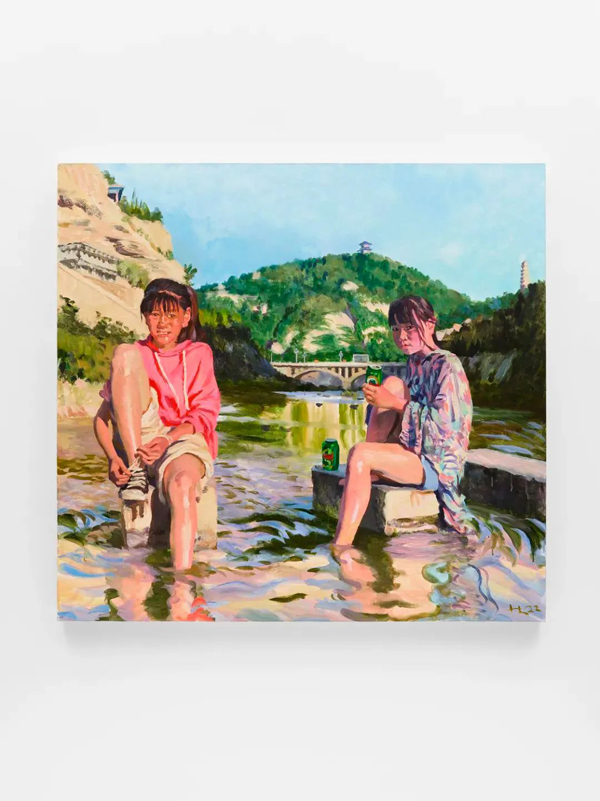
Teenage girls in the Yan River, 2022, oil on canvas, 140 x 150 cm. Courtesy Lisson Gallery
As for the other painting that focuses on the female subject, Wedding Dress and Vegetables (2019) has a distinct atmosphere. A young woman in a Gucci-like outfit sits at a tea table and the room she is in flows an atmosphere of delicate rococo, seemingly indicating that her identity is about to change. Despite this, the wedding dress on the sofa and the scattered objects do not reflect the festive atmosphere that should be there. The three women are all from remote areas of Shaanbei as are the other teenagers in the paintings. These young adolescents wander idle through the fields and rivers they know every day, clearly disconnected from the society outside, which values “elite” and “merit.”
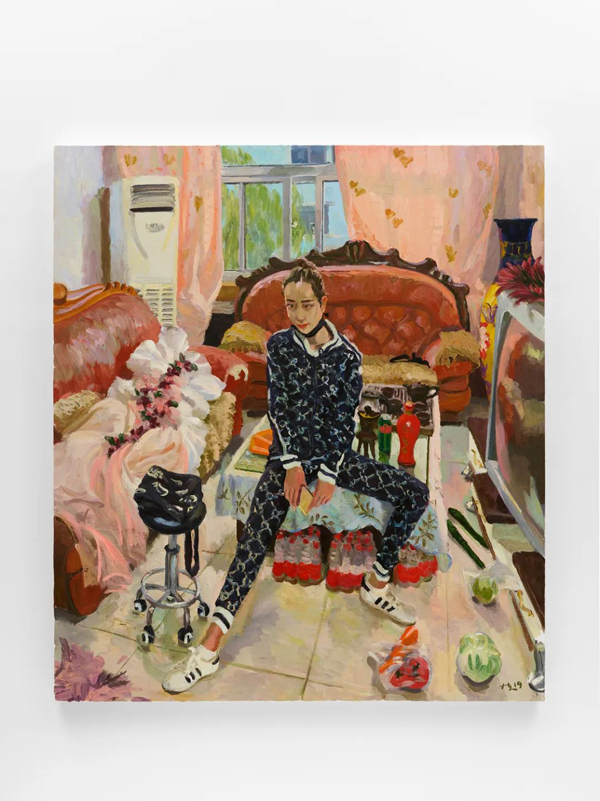
Wedding dress and Vegetables, 2019, oil on canvas, 180 x 160 cm. Courtesy Lisson Gallery
Considering this aspect, one can realize that an artist with a gift for painting demonstrates the potential side of being a director or journalist. The electronics, costumes, and architecture in the paintings reflect the countryside in transition: a mix of modern transformation and contemporary elements amid a primitive countryside landscape. This is analogous to the urban and rural changes reflected in Chinese director Jia Zhangke’s films--those images with rural areas, small counties and metropolitan cities as the backdrop are veiled in gray tones with the melancholy of passing times and separated nostalgia. One would be gradually brought into this emotion in Liu’s painting by his depiction of the general environment, the layout of figures and landscapes, and the vivid status of the characters. A strong sense of sorrow is apparent in Two Men from the Back (2022). The middle-aged man (probably the artist himself) and the older man on the painting’s left are on the yellow ground, one looking at the tall buildings across the river as he walks, and the other seemingly stopping to look ahead. Their gesture and action contrast, and the old man occupies the visual center of the image in the composition. His black back condensed into a serene state that slowed down moving sights, and then the image stood still. Our emotional memories of the fading “back” in Chinese writer Zhu Zhiqing‘s article, as well as those sorrowful and lonely backs in Caspar David Friedrich’s paintings are all evoked.
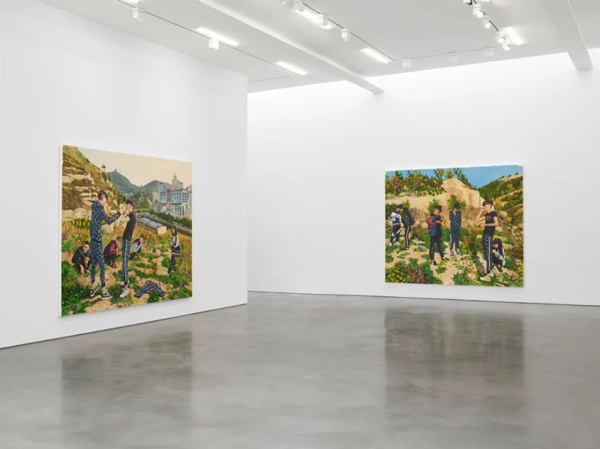
The blue color becomes a focal point, connecting the elderly and the middle-aged man. This painting treatment can also be seen in the work The Kids in the Back (2022) in which a woman playing with a cell phone and a child looking up at the stage are all related together by their blue tops. Both of them are all placed behind two men, one walking straight by with his hands in both pockets and the other seemingly doing a live stream. Like the yellow ground and modern buildings in Two Men from the Back, the booming We-Media phenomenon in China and the background landscape collide to convey the close relationship between industrial urbanization and the countryside.
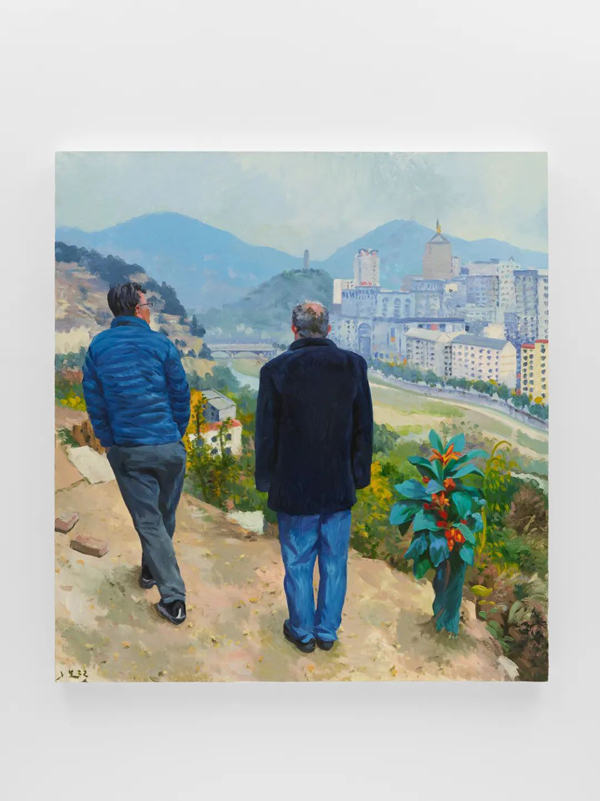
Two Men from the Back, 2022, oil on canvas, 150 x 140 cm. Courtesy Lisson Gallery
The woman who is squatting on the ground appears inconspicuous, but her position in the center of the view allows her to be seen. In Shaanbei and Guanzhong her posture is called “Ge Jiu” which dates back to the Spring and Autumn Period. And there is a highlight of “Guanzhong Dunjing” in Guanzhong’s countryside, which relates to the eating habit, “Lao Wanhui.” The pose was once popular on the Internet and has become known as the “Asian squat” in global culture. It is the same as “the ‘Hunkerin’ popularized at the University of Arkansas in 1959. Students saw it as a symbol of friendship and suggested that world peace would not be far away if Khrushchev and Eisenhower hunkered at the summit (from the November 1959 issue of LIFE magazine).” In Liu’s youth-themed paintings, this pose appears frequently. By changing culture and lifestyle habits, the “squatting” posture gradually disappeared from the public context and became marginalized, as the kilns in the painting. However, the culture invoked by the posture is vital to non-mainstream communities.
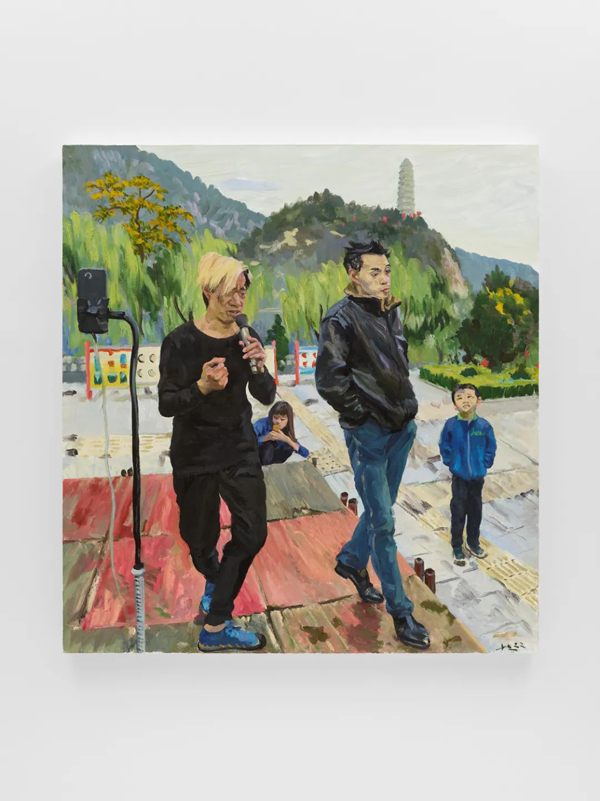
The Kids in the Back, 2022, oil on canvas, 150 x 140 cm. Courtesy Lisson Gallery
Through visiting different regions personally, Liu built individual care for our society. And this time it is both personal sentiment and recognition of the region and culture that prompted him to travel to Shaanbei. When creating, he often chooses local people as characters in his paintings, then sets the scene. In The Roar (2021), an older man with his right hand fist raised exhibits a charging warrior posture whose slightly leaning forward body creates a feeling like he is trying to rush out of the picture. The five older women seated behind him and four men in four positions balance this elder man in visual composition. Also, their lazy and oblivious demeanor demonstrates that the old man’s passion was artificially shaped in a particular context, which has conceptual and performance implications. This can be interpreted as an homage to a generation in the midst of a torrent, as well as a reminiscence of times gone by.
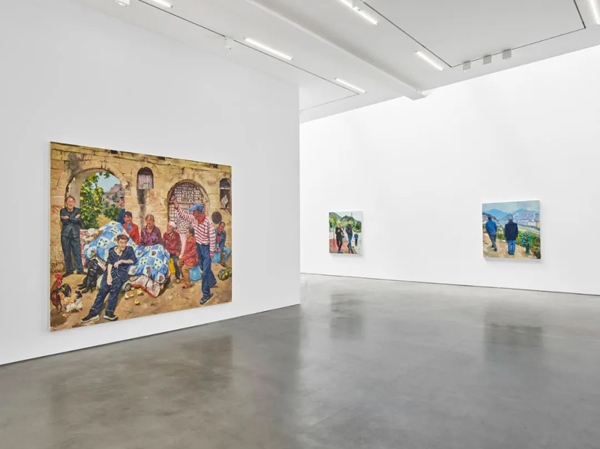
Liu Xiaodong: Shaanbei, Exhibition view. 504 West 24th Street, New York. 4 May – 10 June, 2023. Photography by Mark Waldhauser. Courtesy Lisson Gallery
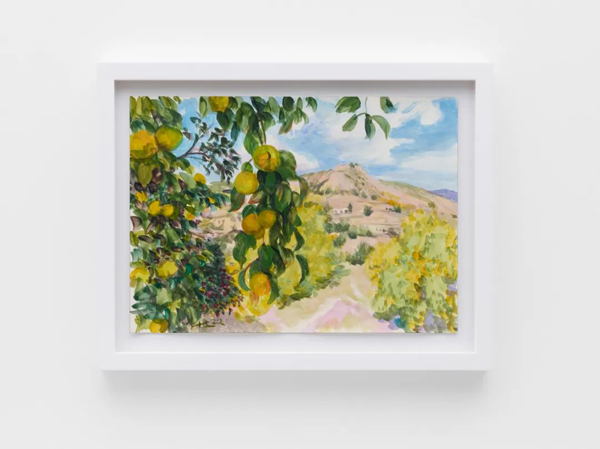
View of Jiajiagou from behind the Pear Trees, 2022, acrylic on paper, 26 x 36 cm. Courtesy Lisson Gallery
Liu can arrange figures according to his own creation, but rural scenes are naturally drawn in his paintings. Through exquisite painting techniques and coordinated colors, he shows us the state of those trees, cows, slopes, and the village in their own environment. Wherein the paintings of Jiajiagou such as View of Jiajiagou from behind the Hawthorn Trees (2022) and View of Jiajiagou from behind the Pear Trees (2022), evoke Mount St. Victor was depicted by Cézanne many times in his later years which is partly a symbol of his identity that holds his personal emotions and his innovation in painting. Liu’s paintings of Jiajiagou’s overlook view, front view, and side view also show his art passion. The constant thinking, polishing, and contemplation he displays is a sign of cherishment and recollection of memories. Having sketched here as a young school boy more than thirty years ago, and today, more than thirty years later, he is back again.

Liu Xiaodong (b.1963) is a painter of modern life, whose large-scale works serve as a kind of history painting for the emerging world. Liu locates the human dimension to such global issues as population displacement, environmental crisis and economic upheaval, but through carefully orchestrated compositions, he walks the line between artifice and reality. A leading figure among the Chinese Neo-Realist painters to emerge in the 1990s, his adherence to figurative painting amounts to a conceptual stance within a contemporary art context where photographic media dominate. His undertaking ‘to see people as they really are’ was galvanised after graduating from the Central Academy of Fine Arts, and his compositions are painted with loose, casual brushstrokes and layered with meaning. While he works from life and often en plein air, he chooses sitters to supply ancillary narratives to landscapes or situations.
Liu Xiaodong has a BFA and an MFA in painting from the Central Academy of Fine Arts, Beijing (1988, 1995), where he now holds tenure as professor. He continued his studies at the Academy of Fine Arts, University of Complutense, Madrid, Spain (1998–99). His work has been the subject of numerous solo exhibitions at venues including the NRW-Forum & Kunsthalle Düsseldorf, Düsseldorf, Germany (2018); Chronus Art Centre, Shanghai, China (2016); Palazzo Strozzi, Florence, Italy (2016); Fondazione Giorgio Cini, Venice, Italy (2015); Shao Zhong Foundation Art Museum, Guangzhou, China (2014); Minsheng Museum, Shanghai, China (2014); Seattle Art Museum, WA, USA (2013); Today Art Museum, Beijing, China (2013); Kunsthaus Graz, Austria (2012); Xinjiang Arts Centre, Urumqi, China (2012); and Ullens Center for Contemporary Art, Beijing, China (2010). His work has also been included in numerous group exhibitions including Qatar Museums Gallery, Doha (2016), Gwangju Biennale (2014), Shanghai Biennale (2000, 2010), the 15th Biennale of Sydney, Australia (2006) and the Venice Biennale, Italy (2013, 1997).


